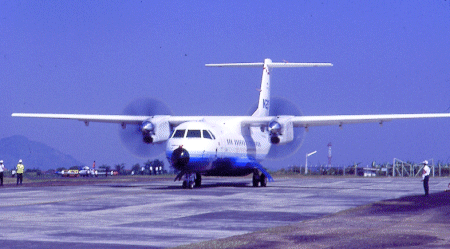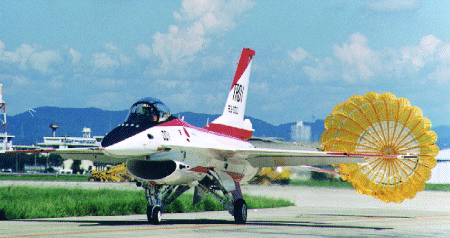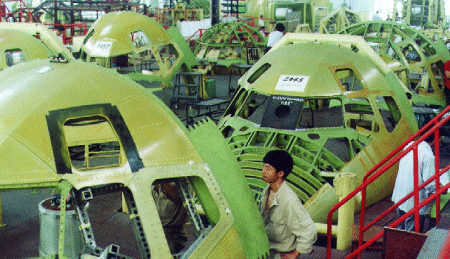Chris Jasper/LONDON

Asia's battered aerospace sector is finally getting to grips with the new realities thrust upon it by the region's patchwork economic collapse of a few years ago - although it has taken its time.
Before currencies nose-dived in 1997, Asia had been gearing up for a major expansion of its aerospace manufacturing capabilities as it sought to capitalise on an anticipated explosion in its own air transport market.
Although that explosion has really only been delayed, the effects of that delay have been devastating for the industry. Flagship projects such as China's TrunkLiner and AE31X have been killed off. Active programmes, including Indonesia's N250, have been strangled by a lack of cash. Ambitious schemes to challenge the West's market leadership - such as Japan's YS-X regional jet family - have died a slow death on the drawing board.
Some projects may yet be revived, and Asia's aerospace industry can certainly look forward to a brighter future in the long term as demand picks up in tandem with economic recovery. Yet to exploit the opportunities that once again loom large, Asia must embrace wholesale restructuring. Such has been the harm done that some companies may not survive.
In the two years since the last Singapore show, the tale unfolding has been that of Asian companies coming to terms with the new economic landscape. Some lessons seem genuinely to have been learned, most notably in South Korea, which is creating from key divisions of its bloated conglomerates, or chaebols, what it hopes will be a new aerospace powerhouse. Elsewhere, national pride seems to have been an obstacle to common sense. Indonesia, for example, has only recently decided to stop throwing cash at a long-term money pit, airframer IPTN.
The key question that all Asia's aerospace players still must address, however, concerns their place in the aerospace hierarchy. In many industries, Asia is home to the very biggest concerns, with Japan's Nissan Motor and South Korea's Samsung Electronics true global giants.
These last two are also active in the aerospace sector - yet aviation and defence activities are hardly core to their operations. Nissan's aerospace work, for example, contributed a pitiful 0.7% of the behemoth's total turnover in 1998.
Aerospace's status as a poor relation afflicts the sector, particularly in South Korea and Japan, Asia's two industrialised giants. Japan's three "heavy industry" groups and South Korea's chaebols have evolved from family businesses, and therefore lack focus. The contrast with the West is stark; Boeing and Lockheed Martin, whatever their failings, are highly focused groups with aerospace manufacturing as their core competency. In Europe, the recent wave of consolidation has established global heavyweights in BAE Systems and the embryonic European Aeronautic, Defense and Space.
Historically, the lack of a significant Asian civil airframer has hindered the industry's evolution and plans for an "Asian Airbus", mooted in 1997 by the Society of Japanese Aerospace Companies, remain a distant dream.
With no home grown "Airbus" around which to coalesce, Asian manufacturers have traditionally satisfied national defence requirements. Since the Second World War, however, the exponential increase in the capital expenditure needed to fund new projects, allied to US dominance in the region, has caused most East Asian countries to order US (or, in a handful of cases, Russian) aircraft, with their companies awarded offset work.
In a sense, an Asian model of aerospace manufacture has developed, with state-owned companies and divisions of conglomerates engaged in military offset work or, in some instances, allowed to manufacture under licence - at the same time offering a small number of indigenous products, often sold only to their own governments. Civil offsets are becoming more common as Asia increases its orders for Western airliners, although these are by their nature dependent upon the Asian transport market's continued expansion.
Such a model clearly leaves much to be desired, and Asia's companies risk being left behind by changes in the industry elsewhere over the last few years. Their Western rivals, for example, are bent on attaining the critical mass needed to compete globally and are aligning their activities accordingly through mergers and divestments.
Moving to a western model
In the short term, the best that Asia can hope for is to reorganise its industry along more rational lines. Here, South Korea has shown the way, by forming Korean Aerospace Industries (KAI) from divisions of Samsung, Hyundai and Daewoo. Each contributes the bulk of its aerospace activities, although the process is confused in that constituent companies will continue to trade under their own names.
A stake of up to 30% in KAI is on offer to overseas investors, with a consortium of Lockheed Martin, Aerospatiale Matra and Carlyle Group pitted against a BAE Systems/Boeing team. The process was complicated by BAE's bid for a 51% stake in Hyundai Space & Aircraft (HSA), a one-third shareholder in KAI, in what was seen as a backdoor move to take a controlling stake in the new company. The bid failed, with Hyundai Motor buying out its KAI stake.
Key KAI projects will include production of the Lockheed Martin F-16 under licence (Samsung Aerospace) and manufacture of the indigenous KT-1 trainer and KTX-2 advanced trainer/light combat aircraft with Lockheed Martin. HSA, established only in 1994, is to contribute to Boeing 717 wing work, but is in dispute with the US airframer over the project.
Korean Air Aerospace has remained outside KAI, although it derives 60% of revenue from military work for the South Korean and US Governments. Such projects include the licence-built UH-60P helicopter and F-16 wing and fuselage work. It makes wing components for the Boeing 747-400, 777 and Next Generation 737, nose sections for the 717, Airbus A330/340 fuselage parts and satellite components with Lockheed Martin and TRW.
While South Korea has taken the first steps towards reforming its aerospace sector, Japan, which has a similar industry structure, has resisted doing so, with the Japan Aircraft Development consortium (JADC) - comprising the three "heavy industries" of Fuji, Mitsubishi and Kawasaki, plus Japan Aircraft Manufacturing and ShinMaywa Industries - proving ineffective. JADC has been studying a new regional jet family, the YS-X, for a decade, but the Asian downturn set the project back years, and the consortium is restricted to the supply of Boeing 777 and 767 structures. While well-positioned for work on future large airliner projects, it chose last year to concentrate on developing a new generation of cockpits.
Some consolidation may be imminent, however, with Ishikawajima-Harima Heavy Industries (IHI) apparently poised to buy Nissan Motor's aerospace subsidiary for $370 million. The two would make a good fit, with Nissan producing launch vehicles and solid-fuel rocket motors, and IHI making aero engines, although the buying power of the latter is uncertain.

Were Japan to follow South Korea's path, it would rank on the fringes of the aerospace "top 10", with a net turnover of about $8 billion. As it is, Mitsubishi Heavy Industries (MHI) Aerospace Systems is Asia's largest industry player, developing the F-16-based F-2 support fighter (above) and Japan's first indigenous helicopter, the MH2000. It supplies components to Boeing, Bombardier and, most recently, for the Airbus A320 family as the European consortium pushes sales in Japan. A pioneer of the H-2 launcher, MHI is to supply the second engine for Boeing's two-engined Delta 4.
If Japan is resistant to wholesale change, China, with an economy still largely state controlled, has opted for a major shake-up of its sprawling industry. Last year, Beijing established 10 "new" state-owned aviation companies, with the two largest formed by splitting Aviation Industries of China into AVIC I and II (China Aviation Industry Corporation I and II).
The former is responsible for the bulk of military and civil aircraft production, including JF-7 and JF-8 fighters, H-5 and H-6 bombers, JT-6 and -7 and HJ-5 trainers, the Y-7 civil aircraft and component supply to Boeing and other Western manufacturers. AVIC II has a significant amount of non-aerospace production, but keeps helicopters and general aviation, and the K-8 trainer and Q-5 strike aircraft.

This upheaval is in part a response to the failure of the TrunkLiner (above) and AE31X joint ventures with Boeing and Airbus, respectively, which Beijing had hoped would help modernise the Chinese aerospace industry. Shanghai Aviation Industrial built 35 McDonnell Douglas MD-80s under licence between 1987 and 1992, and planned to follow these with a further order for 40 MD-90s modified for Chinese runways and dubbed TrunkLiners.
A total of 20 aircraft was to be built in Shanghai and 20 at Long Beach. But, while the latter aircraft were delivered, only two Chinese aircraft have been completed. Beijing cancelled the programme in 1998 because of a lack of airline demand as the Asian economic crisis hit, and because of Boeing's decision to scrap production of all but one of the McDonnell Douglas civil types - the MD-95, now the Boeing 717.
The Airbus/AVIC AE31X joint venture envisaged the manufacture of a new 80-120-seat regional jet family, to be built by Xian Aircraft Industry Group, but this collapsed in early 1998 after Airbus decided the project was no longer viable. To salvage relations, Airbus handed several subcontracts to China, including A320 wing component work (Shenyang and Xian), plus participation in the A318 project.
AVIC responded to these developments by mooting a possible domestic regional jet manufacturing venture, the NRJ, involving several of its subsidiaries and - possibly - Aerospace Industrial Development (AIDC) of Taiwan, although a souring of relations between the two Chinas means that little more has been heard.
The jury is still out on AVIC's reform, with even its own management unconvinced that the move will deliver results, and the influence of government - and the military - still strong. Nevertheless, with AVIC I projecting that China will need 1,474 new aircraft by 2018 - 399 seating fewer than 80 people - it should not be short of licence work for Western airframers.
AIDC privatisation
Across the Taiwan Strait, AIDC, once part of the defence ministry, is gearing up for privatisation, but with little progress. The business should have been partially privatised last year and, although "offering memoranda" have been issued, it may have to restructure into separate civil aerostructures, engines and defence, maintenance and avionics units to attract investors.
AIDC has headed Taiwan's home-grown manufacturing with the AT-3 trainer and Ching Kuo Indigenous Defence Fighter (IDF) but, with the last IDF delivered, it is pinning its hopes on possible jet trainer exports. In the longer term, AIDC needs more civil work. Its civil projects, which account for 20% of revenue, include 717 tail work and the Ibis Aerospace 50:50 venture with Aero Vodochody.
The biggest manufacturing casualty of Asia's decline has perhaps been Indonesia's IPTN. The state-owned company survived for years on hand-outs under its head Bacharuddin Habibie, who became the country's president. Following Habibie's departure the cash dried up, causing IPTN's two flagship projects, the 114-132-seat N2130 regional jet and the N250 turboprop, to be frozen.
Work on the CN235 transport, a joint venture with CASA, continues, but IPTN desperately needs assistance. A foreign partner is apparently being sought, and reports say IPTN could spin off its rotary-wing work, defence and space systems businesses into subsidiaries as it restructures before a hoped-for privatisation.
Elsewhere in the region, smaller players are rediscovering old ambitions, although Malaysia's plans to develop an indigenous manufacturing base from maintenance specialist Airod may be overambitious, and politically driven. Singapore Technologies subsidiary Singapore Aerospace Manufacturing remains a niche player, and recently agreed to form a landing gear venture with Snecma's Messier Dowty, while ST Aero remains active in the upgrade market, modifying F-16s and Northrop F-5s.
Further afield, countries on the fringes of the downturn have made steady progress upward. India's Hindustan Aeronautics is to begin production of the Sukhoi Su-30MK1 multirole fighter under licence, adding it to the Sepecat Jaguars and its own Advanced Light Helicopter and planned HJT-36 trainer.
Source: Flight International



















